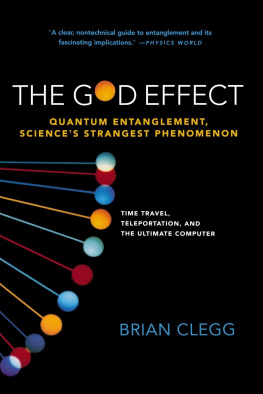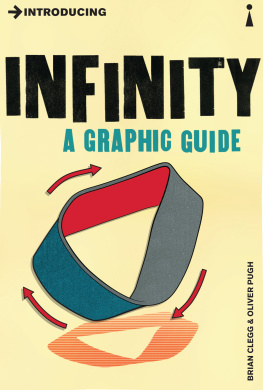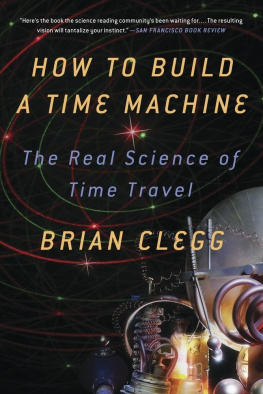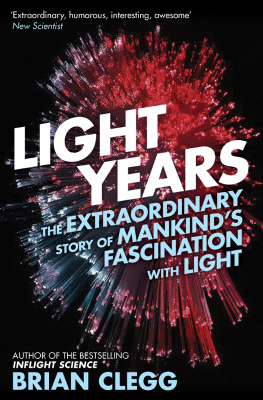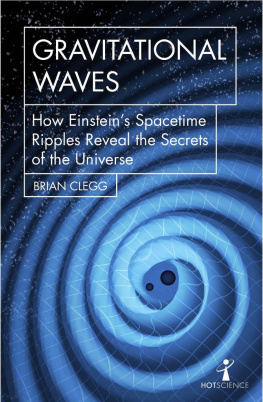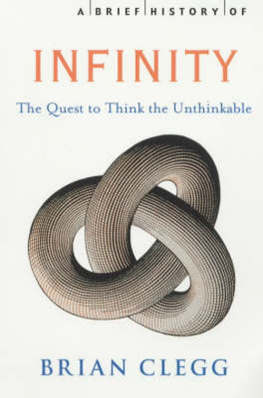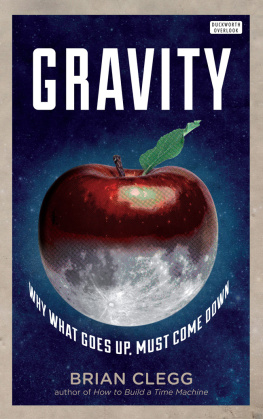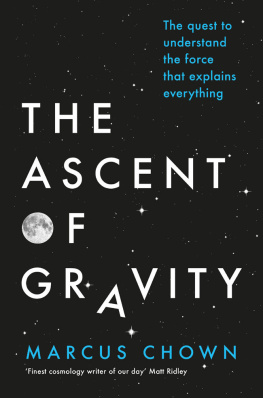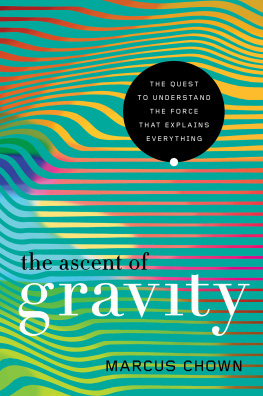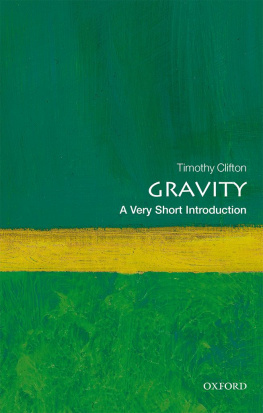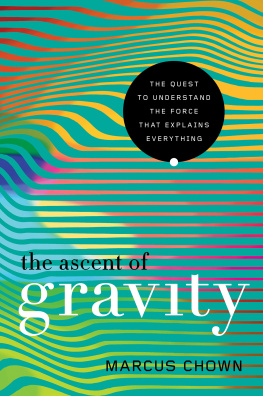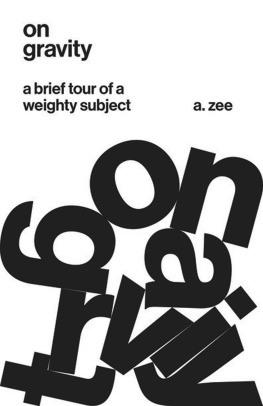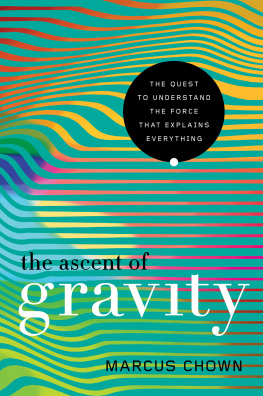
FOR GILLIAN, REBECCA, AND CHELSEA
ACKNOWLEDGMENTS
My grateful thanks to my editor, Michael Homler, for his guidance and support.
Thank you to the many people who have helped me along the way to writing this book, including the staff of the Science Museum Library (Wroughton), Dr. Marcus Chown, Professor Brian Cox, Professor Bob Evans, Dr. Sean Carroll, Professor Peter Haynes, Professor Friedrich Hehl, Professor Michio Kaku, Professor Ronald Mallett, Dr. Peet Morris, and Professor Gnter Nimtz.
CONTENTS
CHAPTER ONE
WHAT GOES UP
So in all their procedinges they shew themselffes to be men of gravyte and wisedom.
State Papers of Henry VIII (1849), VII.614
Hold this book in your hand and let go. What will happen? Its such an obvious question that it feels embarrassing to have to ask it. But humor me. What will happen? You dont have to carry out the experiment to know the answer. The book will fall. Why? Just as embarrassingly obvious. Because of gravity.
This is the most directly obvious force of nature. Its influence is programmed into our expectations of the world around us. If we let go of something and it drifts upward instead of falling, its a double-take moment. Either were dealing with something special, like a helium balloon, or were not firmly planted on the Earth. When we drop things, they fall, simple as that. And yet, as we will discover, the story of gravity is anything but simple.
Gravity is so familiar and apparently obvious that we often miss seeing just how remarkable it is. Most rational people laugh at the idea of astrology. They may tolerate it as fun, but they accept that it is garbage. Its bizarre, they say, that anyone should believe that our lives are influenced in any way by astronomical bodies that are millions of miles away. Yet we accept that gravityan invisible force with no detectable mechanism for exerting an influencecan have a real effect across just such distances. After all, the only thing that keeps the Earth in orbit is the gravitational attraction between it and the Sun, 93 million miles away.
You will sometimes see this distant reach of gravity being used to try to give astrology a scientific basis. We are subject to the gravitational attraction of the planets, the argument goes, so they can have an influence on our lives. While this is strictly true, it is worth bearing in mind that the gravitational force between a human body and the distant planets is tiny. By comparison, the gravitational attraction between a baby and the midwife is greater. So if astrology really were based on this idea, we should have astrological charts including the position and mass of the midwife, and everything else that was present at the birth.
In the real world of science, gravity has a much greater effect on us than anything astrologers could even imagine. Without gravity there are just so many ways that we wouldnt exist or be able to carry out our everyday activities. It isnt just a convenient way of sticking to the surface of the Earth.
It is thanks to gravity that bodies like planets and stars came into existence in the first place. Just imagine you are visiting the site of the solar system before it formed, around 4.5 billion years ago. You are looking at a cloud of mattergas and dust floating in space. There is no wind to disturb this collection of material, so it will not be blown from place to place, but there is gravity. Each of the specks of matter has a tiny influence on the others. Gradually, painfully slowly, the matter will be pulled together.
At the same time the whole thing is rotating. Thats the way it started out, and there is nothing to stop it. So as the matter bunches together, it is also whirling around, like the disk of a pizza as the dough is spun between the hands of the baker. Eventually, at the center of this whirling cloud will be a large clump of matter. As each new particle comes crashing in, it will add energy, producing heat. (Think of the way rubbing your hands together produces heat. Its a much smaller effect for each particle but there are many billions of particles contributing.)
After millions of years of collecting particles in this central lump there will be enough heat and pressure from the gravitational pull of the accumulated mass for something remarkable to happen. Hydrogen atoms (or to be more precise hydrogen atoms each stripped of its electron to leave hydrogen ions, simple protons) will be forced closer and closer together with more and more energy. Eventually a reaction will occur. In a multistage process the hydrogen nuclei fuse to form helium, the next element up the chemical chain. In this process energy is released.
The released energy from the nuclear fusion gives even more oomph to the reaction, sending it snowballing through the mass of the central lump. What we are seeing is a star being kickstarted. The fusion process is the power source of the star. Without gravity, this could never have happened.
As described above, the process has one flaw. The positively charged hydrogen ions do not like to get near to each other. The closer you push them, the more the electrical charge fights back. The electromagnetic force causing this repulsion is much stronger than gravity. Even all the gravitational pressure of a star, plus the heat that has built up, is not enough to force the positively charged ions close enough together to fuse.
The final hurdle is overcome by quantum effects. Just as general relativitythe theory that explains gravitydeals with the very large, quantum theory explains the behavior of the very small. One of the oddities of quantum particles, like hydrogen nuclei, is that they dont have a specific position. They just have a range of probabilities as to where they might be. So although a pair of hydrogen nuclei are most likely to be held too far away to fuse by repulsion, this quantum uncertainty enables some particles to perform a process called quantum tunneling.
The particles have a small probability of finding themselves on the other side of the gap separating them without traveling through the space in between. Although the chances of any particular particle undergoing tunneling are very low, there are so many particles in a star that vast quantities of them make this jump every second. The Sun, for example, converts around 4 million tons of matter into energy every second, all derived from the minute difference in mass that arises when particles fuse.
In a normal star there is a balance, an equilibrium between the inward gravitational pull that drags all the particles in the star toward its center, and outward pressure. This pressure is a combination of traditional gas pressurethe result of the gas particles in the star bouncing off each other and resisting collapseand the pressure of the light emitted in the fusion process. This reaction is going on deep in the Sun. When mass converts to energy it comes out as light. But the light doesnt come straight outfar from it.
Any particular photon of light will only travel a tiny distance before colliding with another matter particle and being absorbed. The light is then reemitted. This process acts as if the light were another particle that has bounced off the matter. As a result it gives some energy to the matter. The reemitted photon is slightly lower energy and the extra energy of the matter particle results in extra pressure resisting the collapse of the star.
As the photons very gradually make their way out of the star, they reduce in energy all the way. This is reflected in the differences in temperature through the cross section of a star. The Sun, for example, has a core temperature of around 10 million degrees Celsius (18 million F), while the outer layer that we see is only around 5,500 degrees Celsius (9,900 F). There are so many absorptions and reemissions along the way that photons take somewhere between 10,000 and 1 million years to get out of the Sun.
Next page

